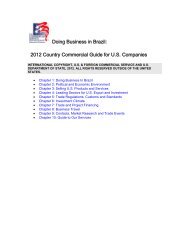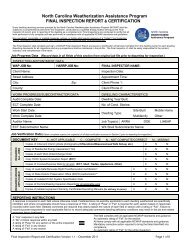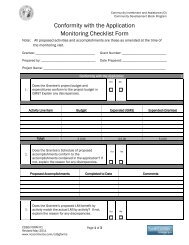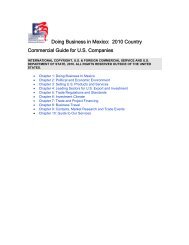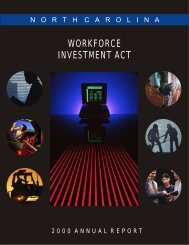Section 3 - HUD
Section 3 - HUD
Section 3 - HUD
You also want an ePaper? Increase the reach of your titles
YUMPU automatically turns print PDFs into web optimized ePapers that Google loves.
<strong>Section</strong> 3What is <strong>Section</strong> 3?<strong>Section</strong> 3 is a provision of the Housing and Urban Development (<strong>HUD</strong>) Act of 1968that helps foster local economic development, neighborhood economic improvement,and individual self-sufficiency. The <strong>Section</strong> 3 program requires that recipients ofcertain <strong>HUD</strong> financial assistance, to the greatest extent feasible, provide job training,employment, and contracting opportunities for low- or very-low income residents inconnection with projects and activities in their neighborhoods.How does <strong>Section</strong> 3 promote self- sufficiency?<strong>Section</strong> 3 is a starting point to obtain job training, employment and contractingopportunities. From this integral foundation coupled with other resources comes theopportunity for economic advancement and self-sufficiency.• Federal, state and local programs• Advocacy groups• Community and faith-based organizationsHow does <strong>Section</strong> 3 promote homeownership?<strong>Section</strong> 3 is a starting point to homeownership. Once a <strong>Section</strong> 3 resident hasobtained employment or contracting opportunities they have begun the first step toself-sufficiency.Remember, “It doesn’t have to be fields of dreams”. Homeownership is achievable.For more information visit our <strong>HUD</strong> website.Who are <strong>Section</strong> 3 residents?<strong>Section</strong> 3 residents are:• Public housing residents or• Persons who live in the area where a <strong>HUD</strong>-assisted project is located and whohave a household income that falls below <strong>HUD</strong>’s income limits.Determining Income Levels• Low income is defined as 80% or below the median income of that area.• Very low income is defined as 50% or below the median income of that area.What is a <strong>Section</strong> 3 business concern?A business that:• Is 51 percent or more owned by <strong>Section</strong> 3 residents;• Employs <strong>Section</strong> 3 residents for at least 30 percent of its full-time, permanentstaff; or
• Provides evidence of a commitment to subcontract to <strong>Section</strong> 3 businessconcerns, 25 percent or more of the dollar amount of the awarded contract.What programs are covered?<strong>Section</strong> 3 applies to <strong>HUD</strong>-funded Public and Indian Housing assistance fordevelopment, operating, and modernization expenditures.<strong>Section</strong> 3 also applies to certain <strong>HUD</strong>-funded Housing and Community Developmentprojects that complete housing rehabilitation, housing construction, and other publicconstruction.What types of economic opportunities are available under <strong>Section</strong> 3?• Job training• Employment• ContractsAny employment resulting from these expenditures, including administration,management, clerical support, and construction, is subject to compliance with<strong>Section</strong> 3.Examples of Opportunities include:• Accounting• Architecture• Appliance repair• Bookkeeping• Bricklaying• Carpentry• Carpet Installation• Catering• Cement/Masonry• Computer/Information• Demolition• Drywall• Electrical• Elevator Construction• Engineering• Fencing• Florists• Heating• Iron Works• Janitorial• Landscaping• Machine Operation• Manufacturing• Marketing• Painting• Payroll Photography• Plastering• Plumbing• Printing Purchasing• Research• Surveying• Tile setting• Transportation• Word processingWho will award the economic opportunities?Recipients of <strong>HUD</strong> financial assistance will award the economic opportunities. Theyand their contractors and subcontractors are required to provide, to the greatestextent feasible, economic opportunities consistent with existing Federal, State, andlocal laws and regulations.
Who receives priority under <strong>Section</strong> 3?For training and employment:• Persons in public and assisted housing• Persons in the area where the <strong>HUD</strong> financial assistance is spent• Participants in <strong>HUD</strong> Youthbuild programs• Homeless personsFor contracting:• Businesses that meet the definition of a <strong>Section</strong> 3 business concernHow can businesses find <strong>Section</strong> 3 residents to work for them?Businesses can recruit <strong>Section</strong> 3 residents in public housing developments and in theneighborhoods where the <strong>HUD</strong> assistance is being spent. Effective ways of informingresidents about available training and job opportunities are:• Contacting resident organizations, local community development andemployment agencies• Distributing flyers• Posting signs• Placing ads in local newspapersAre recipients, contractors, and subcontractors required to provide longtermemployment opportunities, not simply seasonal or temporaryemployment?Recipients are required, to the greatest extent feasible, to provide all types ofemployment opportunities to low and very low-income persons, including permanentemployment and long-term jobs.Recipients and contractors are encouraged to have <strong>Section</strong> 3 residents make up atleast 30 percent of their permanent, full-time staff.A <strong>Section</strong> 3 resident who has been employed for 3 years may no longer be countedtowards meeting the 30 percent requirement. This encourages recipients to continuehiring <strong>Section</strong> 3 residents when employment opportunities are available.What if it appears an entity is not complying with <strong>Section</strong> 3?There is a complaint process. <strong>Section</strong> 3 residents, businesses, or a representative foreither may file a complaint if it seems a recipient is violating <strong>Section</strong> 3 requirementsare being on a <strong>HUD</strong>-funded project.Will <strong>HUD</strong> require compliance?Yes. <strong>HUD</strong> monitors the performance of contractors, reviews annual reports fromrecipients, and investigates complaints. <strong>HUD</strong> also examines employment and
contract records for evidence that recipients are training and employing <strong>Section</strong> 3residents and awarding contracts to <strong>Section</strong> 3 businesses.How can <strong>Section</strong> 3 residents or <strong>Section</strong> 3 business concerns allege <strong>Section</strong> 3violations?You can file a written complaint with your local <strong>HUD</strong> Field Office.A written complaint should contain:• Name and address of the person filing the complaint• Name and address of subject of complaint (<strong>HUD</strong> recipient, contractor orsubcontractor)• Description of acts or omissions in alleged violation of <strong>Section</strong> 3• Statement of corrective action sought i.e. training, employment or contracts




